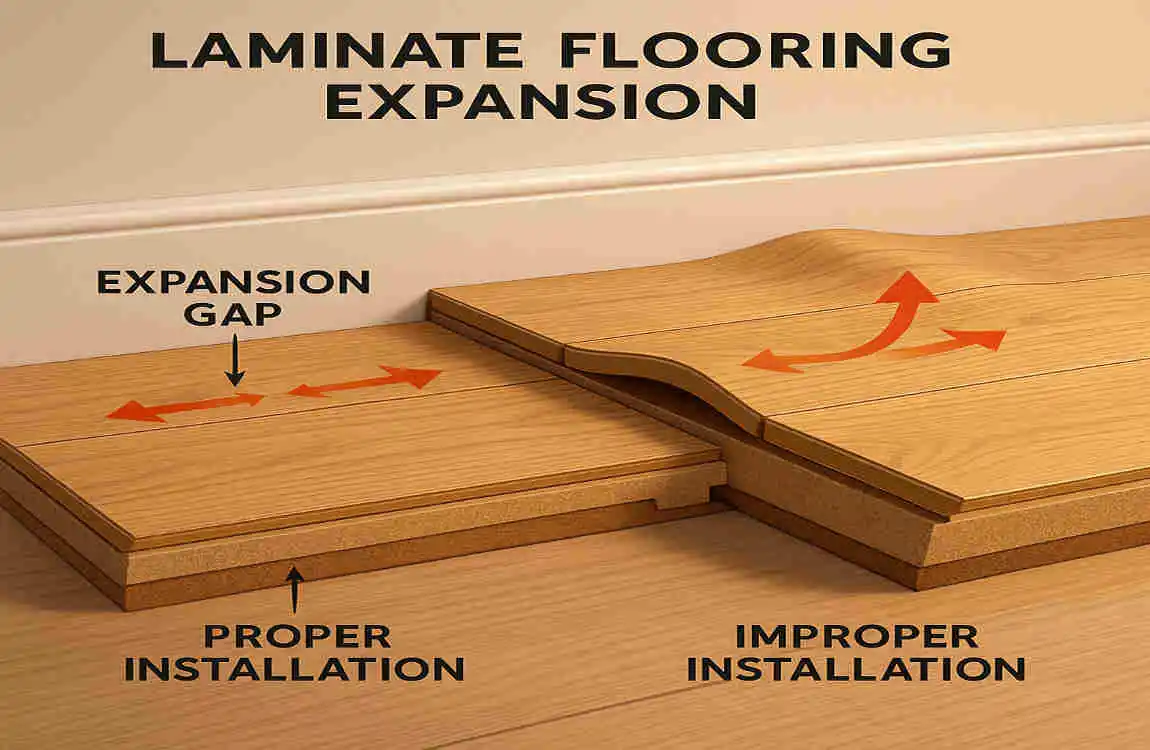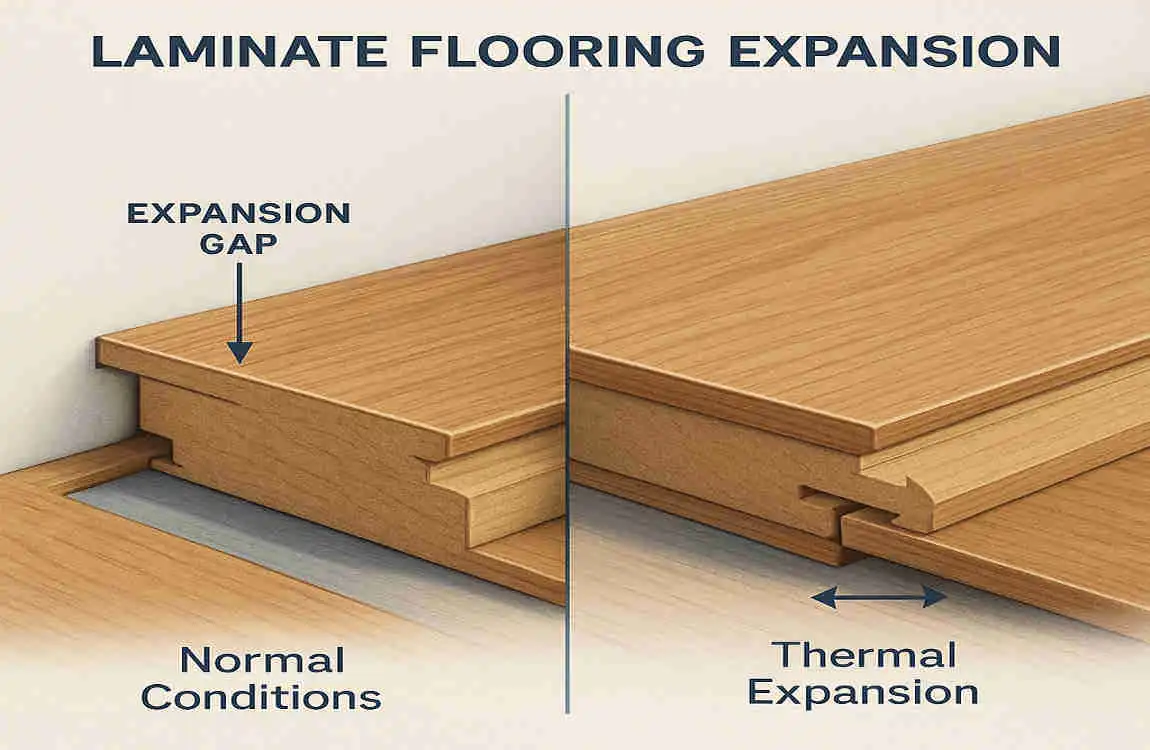Laminate flooring has become one of the most popular choices for homeowners looking to combine style, durability, and affordability. Its wood-like appearance and easy maintenance make it a top pick for many rooms in the house.
But if you’re considering laminate flooring, understanding how laminate flooring expands is absolutely crucial. Without this knowledge, you might face issues like buckling, gaps, or warping that can shorten your floor’s lifespan and spoil its look.
From installation tips to maintenance advice, you’ll get everything you need to keep your laminate flooring looking great for years.
What Is Laminate Flooring Expansion?

Defining Laminate Flooring Expansion
Expansion in laminate flooring refers to the natural increase in the size of the flooring planks after installation. This happens because laminate is made of composite layers, including a wood-based core that absorbs moisture and reacts to temperature changes.
You may also read (experience luxury and comfort at amini house).
When the flooring absorbs moisture or experiences heat, the planks swell slightly, which is called expansion. Conversely, when the environment dries out or cools down, the planks shrink or contract.
Why Does Laminate Flooring Expand?
The main drivers behind expansion are:
- Humidity: When the air is moist, laminate planks soak up water vapor and swell.
- Temperature: Warmer temperatures cause materials to expand; cooler temperatures cause contraction.
- Moisture: Direct moisture from spills, leaks, or damp subfloors can cause more significant swelling.
How Expansion Affects Flooring Performance and Longevity
If laminate flooring does not have room to expand, the pressure between planks can cause:
- Buckling or warping
- Gaps or separation
- Cracking or popping noises
This puts stress on the floor, reducing its lifespan and sometimes causing permanent damage.
Laminate vs. Hardwood Expansion Tendencies
While both laminate and hardwood floors expand and contract, hardwood is more sensitive to moisture because it’s solid Wood. Laminate, with its synthetic wear layer and dense core, tends to grow less but still needs room to move.
How Much Does Laminate Flooring Expand?

Typical Expansion Measurements
On average, laminate flooring expands about:
- 1/8 inch (3 mm) to 1/4 inch (6 mm) per 8 feet (2.4 meters) of flooring length.
This might seem small, but over large rooms or hallways, it adds up.
Factors Influencing Expansion
Several factors affect precisely how much laminate flooring expands:
- Climate and Weather: Humid climates cause more swelling; dry climates less.
- Indoor Humidity Levels: Homes with poor ventilation or high moisture inside see more expansion.
- Quality and Thickness of Laminate: Thicker, higher-quality laminate can be more stable, but still expands.
- Subfloor Type and Installation Environment: Concrete subfloors often hold moisture, increasing expansion risks.
Real-World Examples of Expansion Distances
Imagine a 20-foot-long hallway. If your laminate expands by 1/8 inch every 8 feet, you could see up to 1/4 inch of total expansion along that stretch. That’s why expansion gaps are critical.
You may also read (what are the most popular diy home projects in 2025).
Expert Insights on the Focus Keyword
Experts agree that laminate flooring typically expands between 1/8 and 1/4 inch over 8 feet; however, this expansion rate depends heavily on your local environment and the quality of installation. Manufacturers usually specify exact expansion gap sizes based on this data.
Signs of Laminate Flooring Expansion Problems
Common Symptoms of Improper Expansion Gaps
If your laminate floor wasn’t given enough room to expand, watch for these signs:
- Buckling or Warping: Boards lift or curve upwards.
- Gaps or Separation: Planks pull apart, leaving visible cracks.
- Cracking or Squeaking Noises: Floors creak or snap when walked on.
How to Identify These Issues Early
Early detection is key! Look for uneven surfaces or listen for noises, especially during seasonal changes. Catching problems early can save costly repairs.
Importance of Expansion Gaps in Laminate Flooring Installation
What Are Expansion Gaps and Why Are They Necessary?
Expansion gaps are small spaces left around the edges of the floor to allow the planks to expand and contract without causing damage.
Recommended Size for Expansion Gaps
| Flooring Length | Expansion Gap Size |
|---|---|
| Up to 10 feet | 1/4 inch (6 mm) |
| 10-20 feet | 1/2 inch (12 mm) |
| Over 20 feet | 3/4 inch (18 mm) |
These gaps may seem small, but they are essential to prevent buckling.
How to Leave and Cover Expansion Gaps
After leaving the gaps, installers cover them with:
- Baseboards
- Quarter-round molding
These trim pieces hide gaps while still allowing floor movement.
Consequences of Neglecting Expansion Gaps
Ignoring expansion gaps can lead to:
- Floor damage
- Voided manufacturer warranties
- Costly repairs or replacement
Installation Tips to Accommodate Laminate Flooring Expansion
Preparing the Subfloor Properly
Make sure your subfloor is:
- Clean and dry
- Level and smooth
- Moisture-free, especially for concrete
This prevents moisture buildup that worsens expansion.
Ideal Room Temperature and Humidity Levels
Keep your home at stable conditions during installation:
- Temperature: 65°F to 85°F (18°C to 29°C)
- Humidity: 35% to 65%
This helps planks acclimate properly.
How to Stagger Plank Joints
Stagger the seams of laminate planks to:
- Reduce stress points
- Allow natural movement without cracking
Using Appropriate Underlayment
Underlayment:
- Absorbs minor moisture
- Provides cushioning
- Helps with soundproofing
Choose one compatible with your laminate type.
Professional Installation vs. DIY Considerations
While DIY is possible, professional installers:
- Ensure correct expansion gaps
- Prepare the subfloor properly
- Avoid common mistakes that cause expansion issues
How Seasonal Changes Affect Laminate Flooring Expansion
Impact of Seasonal Humidity and Temperature Fluctuations
Laminate floors expand in summer (high humidity, heat) and contract in winter (dry, cold air). This natural cycle causes visible gaps or slight buckles if gaps are insufficient.
Tips for Managing Laminate Flooring During Seasonal Changes
- Maintain indoor humidity with humidifiers/dehumidifiers.
- Avoid excessive water spills.
- Check and adjust expansion gaps if needed.
Long-Term Maintenance Strategies
- Regularly inspect edges and seams.
- Control indoor climate consistently.
- Clean floors with recommended products that don’t add moisture.
Solutions and Repairs for Laminate Flooring Expansion Issues
How to Fix Buckled or Warped Laminate Flooring
- Remove affected planks.
- Check for moisture issues.
- Reinstall with proper expansion gaps.
When to Adjust or Add Expansion Gaps After Installation
If you notice buckling, carefully remove trim and trim down planks if needed to create space.
Repairing Gaps and Squeaking
- Use floor leveling compounds under planks.
- Tighten loose planks or replace damaged ones.
When to Call a Professional
If problems persist or cover large areas, professionals can assess and fix issues safely.
Comparing Laminate Flooring to Other Flooring Types Regarding Expansion
Expansion Behavior of Different Floorings
| Flooring Type | Expansion Rate | Notes |
|---|---|---|
| Laminate | 1/8 to 1/4 inch/8 ft | Moderate expansion, needs gaps |
| Vinyl Plank | Very low | More dimensionally stable |
| Hardwood | Higher than laminate | Sensitive to humidity, needs expansion gaps |
| Engineered Wood | Lower than hardwood | More stable than solid wood |
Pros and Cons of Laminate Expansion Characteristics
Pros:
- Generally stable
- Easier to maintain than hardwood
- Cons:
- Still needs expansion gaps
- Moisture sensitive
Ideal Use Cases Based on Expansion Tolerance
Laminate works well in living rooms and bedrooms with controlled climates, but it is less ideal in bathrooms or basements without adequate moisture control.
Conclusion
Understanding how much laminate flooring expands and why it happens is essential for any homeowner planning to install or maintain laminate floors. Proper installation with adequate expansion gaps, controlling indoor humidity, and regular maintenance can help prevent common problems such as buckling and gaps.
If you’re unsure about installation or notice issues, consulting a flooring professional can save you time and money. Your laminate flooring deserves the best care to stay beautiful and durable for years.
You may also read (are sliding screen doors available in standard sizes what homeowners need to know).




